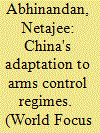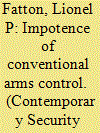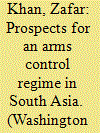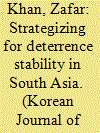| Srl | Item |
| 1 |
ID:
116213


|
|
|
| 2 |
ID:
146811


|
|
|
|
|
| Contents |
Amid tensions with the West over Ukraine, Russia pulled out of the Treaty on Conventional Armed Forces in Europe in March 2015. The Russian case is another example of a country disengaging from conventional arms control when relations with other member states deteriorate. This raises an important question: can arms control regimes aimed at preventing conflict survive periods of tension and preserve peace? This article argues no. It demonstrates that the prospect and stability of conventional arms control regimes depend on healthy international relations. In times of tension, governments rely on military institutions for advice and absorb military biases incompatible with arms control. Therefore, these regimes fail when most needed and are impotent as instruments of peace. Beyond conventional arms control, the article hints at the fragility of nuclear agreements such as the 2015 Iran deal and the 2010 New START between the United States and Russia.
|
|
|
|
|
|
|
|
|
|
|
|
|
|
|
|
| 3 |
ID:
145766


|
|
|
|
|
| Summary/Abstract |
There have been several confidence-building measures (CBMs) between India and Pakistan in both the pre- and post-nuclear periods. There was even a proposal to create a strategic restraint regime, whereby both India and Pakistan could eventually create institutions that could avoid the crises triggering conventional and nuclear conflict. However, these CBMs have failed to produce promising results because of enduring interstate rivalry between the two countries, and have played little or no role in sustaining peace and strategic stability in South Asia. The Kargil conflict of 1999, the common border confrontation in 2001–2002 on the Line of Control, and the Mumbai terror attack in 2008 (attributed to a Pakistani group) all highlight the enduring standoff between the two states.
|
|
|
|
|
|
|
|
|
|
|
|
|
|
|
|
| 4 |
ID:
147398


|
|
|
|
|
| Summary/Abstract |
Before the arrival of nuclear weapons in South Asia, both India and Pakistan had fought several wars. The arrival of nuclear weapons has made both the South Asian nuclear weapons states more cautious to fight. This caution and restraint is directly associated with the fear of using nuclear weapons, the damage of which remains unacceptable to both the adversaries. Although nuclear weapons are considered for deterrence purposes and they are assumed to provide deterrence stability, they are not a guaranteed panacea for all the outstanding issues including the core issue of Kashmir. This absence of a guaranteed solution for these problems despite the presence of nuclear weapons entails the deterrence instability in South Asia, even though neither India nor Pakistan are directly fighting anymore because of the fear of major military escalation to a nuclear use. This paper talks about at least three major dynamics associated with nuclear weapons that might help promote deterrence stability in South Asia. It asks for the consistent practice of minimum deterrence that was initially conceptualized, focuses on the practices of defensive doctrinal postures between India and Pakistan, and calls for an arms control regime (ACR) that does not yet exist in South Asia. In addition to other peaceful measures discussed in the existing literature, the amalgamation of these three ingredients and the commonalities within them could play an important role in promoting deterrence stability in South Asia.
|
|
|
|
|
|
|
|
|
|
|
|
|
|
|
|